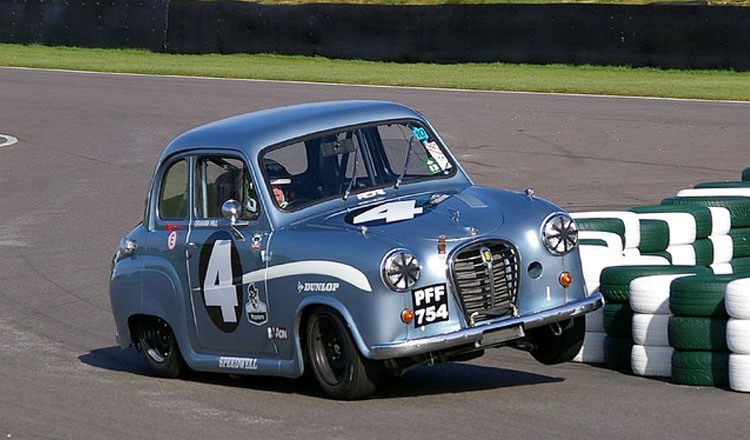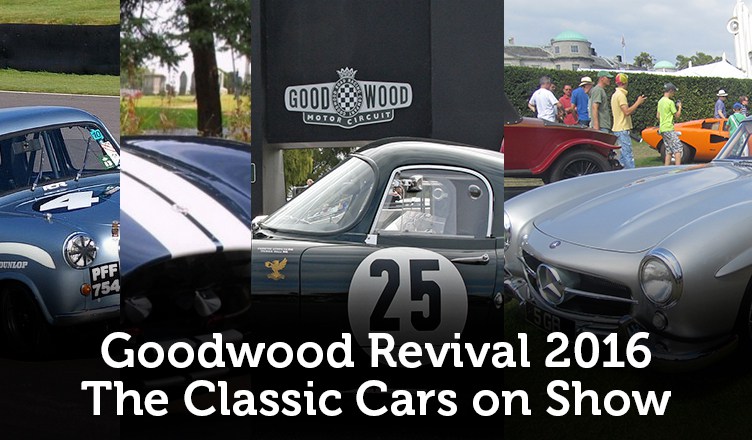In the second of our Goodwood Revival blogs, we take a look at just some of the classic cars that will feature at this year’s historic motor racing event. Amongst others being driven part way around the famous 2.4 mile Goodwood Circuit and hillclimb course are the AC Cobra, Mercedes-Benz 300SL Gullwing, Jaguar E-Type and Austin A35.

AC Cobra
First produced: 1962
Assembly: Surrey, England and Los Angeles, California
Brief history: The 2-door roadster was developed between the UK and US after Carroll Shelby – the American car designer – asked AC to manufacturer a car that would be capable of accepting a V8 engine. Chevrolet were approached first, but declined as they saw this as a potential rival to their Corvette. Ford, however, agreed as they were happy to have a competitive car against the Corvette, and two engines which had already been developed were supplied to Shelby.
The AC Cars operation in Surrey fitted their preliminary chassis with the borrowed Ford engines, but after extensive testing and refinement, removed the engines and instead transported the chassis to Shelby in early 1962. Shelby’s team fitted their own engines and transmission and began road-testing days later.

Mercedes-Benz 300SL Gullwing
First produced: 1954
Assembly: Stuttgart, Germany
Brief history: The fastest production car of its era, the Mercedes-Benz 300SL Gullwing is possibly one of the world’s most iconic cars, more than 50 years after it was first introduced onto the market. Originally built as a coupe, it wasn’t long before it was in production as a roadster also.
New York car dealer Max Hoffman was the man responsible for persuading Mercedes to produce the 300SL, after numerous requests from his dealers for a car that would suit wealthy speed fanatics in the post-war US market. Making its inaugural debut at the 1954 New York Auto Show, it was an instant hit, with approximately 1,400 coupe versions being produced and more than 1,800 roadsters going into production.

Jaguar E-Type
First produced: 1961
Assembly: Coventry, England
Brief history: The car which Enzo Ferrari once declared was “The most beautiful car ever made”, the Jaguar E-Type is a stunning combination of classic good looks and performance. Designed by British car designer Malcolm Sayer, its unmistakable appearance was partly borrowed from its predecessor, the Jaguar D-Type, which took part in and successfully won the 24 Hours of Le Mans for three years straight between 1955 and 1957.
Since its launch, the E-Type has received numerous plaudits and nods of approval from around the world, making it not only a highly sought-after prize possession, but also one of the most recognizable cars on the road.

Austin A35
First produced: 1956
Assembly: Longbridge, England
Brief history: As family cars go, there was little to rival the Austin A35 during its years of production between 1956 to 1968. As a replacement for the already popular A30 model, the A35 had an easier entry to the automotive market; its main differences included a painted grille on the front and a larger window at the rear. As with the A30, two and four-door options were available, meaning that consumers were not missing anything that the A30 already offered.
Its practical offerings and classic looks were not just for its era; an A35 van appears in Aardman Animations’ 2005 film Wallace & Gromit: The Curse of the Were-Rabbit, and their 2008 short A Matter of Loaf and Death.
Talk to us about classic car finance
If you’re considering owning a classic car instead of a newer model, we’re able to offer a wide range of car finance options. We have several specialist lenders on our panel who will consider lending to individuals purchasing a classic car.
If you’re interested in classic car finance, apply by completing our 2-minute application form or get in touch with one of our Customer Advisors today on 0800 1777 290; they’ll be able to answer any questions you may have and assist you throughout the process.





 Facebook
Facebook Twitter
Twitter Instagram
Instagram LinkedIn
LinkedIn Youtube
Youtube